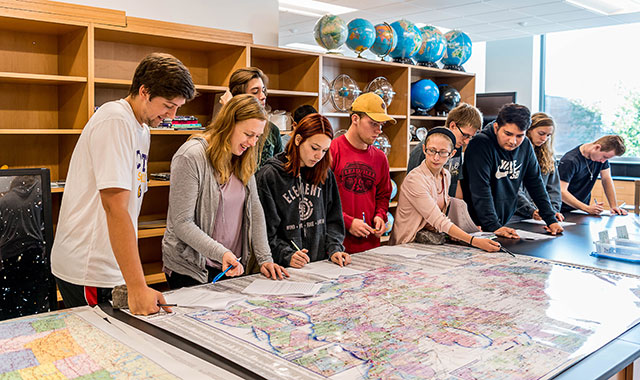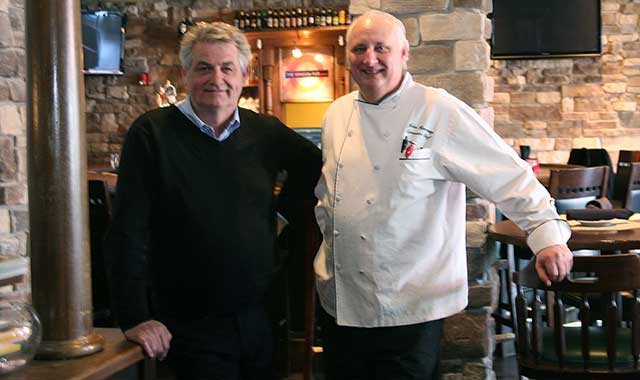Teachers and staff can’t say enough about the new Liebman Science Center at McHenry County College. Step inside this hub for science education and learn about its many modernized features.

Students at McHenry County College (MCC) in Crystal Lake now have access to a state-of-the-art facility that’s serving as a modernized hub for science education.
Liebman Science Center, the college’s new 40,800-square-foot, two-story building, is designed to give students the advanced knowledge and skills needed to be successful in job fields involving science, technology, engineering and mathematics.
The classroom and lab expansion, which is connected to the existing campus, hosted its first classes this past fall.
“Nearly all students pursuing degrees at MCC will study and learn within the Liebman Science Center,” says Christina Haggerty, vice president of marketing, communications and development. “The community’s future engineers, teachers, social workers, accountants, chefs and health care workers all must take at least one science lab class when starting their studies.”
Construction started in spring 2017, after years of discussions among the MCC Board of Trustees about giving the college’s science facilities a major upgrade.
Among the 22,000 square feet of classroom and lab space are a cadaver lab, two lecture halls and a planetarium.
“The Liebman Science Center allows students to learn how to see the physical world through observable evidence, reasoning and testing,” says Chris Gray, the college’s vice president of academic affairs and workforce development. “The center provides state-of-the-art technology to allow our students to access materials, both hands-on and virtually, that we have not been able to access in the past.”
College president Clint Gabbard believes the new center provides an important advantage to McHenry County residents.
“We hope that every student who uses this building for a class is encouraged to use their learning experience to think about how to make their community and their world a better place,” Gabbard says. “The architecture, design, construction and classrooms should tell our students that they don’t have to settle for less when they turn to the community college for a piece of their education. They deserve and can have the best.”

The science center boasts large, oversized windows that let in natural sunlight. There are also several collaboration spaces where students can charge their devices, conference as they complete their coursework or meet with teachers.
The first floor holds biology labs and prep space, anatomy and physiology labs, a cadaver lab, lecture hall, a student resource room and various student collaboration spaces.
Head up to the second floor and you’ll find chemistry labs, a physics lab, earth science labs, a planetarium, a weather center and additional collaboration spaces.
The planetarium features a digital projection system that displays an arrangement of stars and planets on an 8.3-meter dome, along with theater-style seating for 45 people. MCC is one of only four community colleges in the state that boasts this kind of technology, Haggerty says.
“With this planetarium, future astronomers and meteorologists have access to the latest technology and the best learning environment possible,” she says. “The planetarium supports earth science courses, including astronomy and meteorology.”
A unique highlight of the building is the planetarium’s window, which lights up at night on the north side of the building. It displays one of the first images captured by the Hubble telescope: the Tarantula Nebula, one of the largest documented star-forming regions in our galaxy.
“I am no longer limited to showing a still image or video to represent celestial objects of space during class,” says astronomy instructor Paul Hamill. “Now, I can fly past the craters on the moon, and fly to Saturn or to the volcanoes on Mars.”
The $17 million science center is paid for with a combination of private donations, college funds and student fees. A $5 million donation from local resident and longtime college supporter Charles Liebman and his family started the fundraising campaign, which is nearing its $7 million fundraising goal. For his generosity, the building bears the family’s name.
In keeping with its emphasis on science and technology, MCC’s newest building is a showcase of eco-friendly features. Innovative designs help to measure water efficiency, indoor air quality and energy savings with overall lower maintenance costs than traditional buildings. Plumbing features promise to use as much as 30 percent less water than standard fixtures.
Other sustainable features include an electric vehicle charging station, a bicycle rack, dedicated parking spaces for low-emitting vehicles and all-LED lighting both indoors and out.
Native species of trees, shrubs and plants surround the building and an outdoor classroom featuring a crushed granite teaching pad and a compass rose sundial.
“We have built in some outdoor learning spaces to show students that learning happens everywhere, not just in a classroom,” Gabbard says.

The science center also comes equipped with a GeoScene wall, a colorful geological structure near the main entrance that students can use while investigating various geologic patterns. Measuring more than 5 feet tall and 16 feet wide, it’s the largest of its type in the country, Haggerty says, and it represents all three rock types: igneous, sedimentary and metamorphic.
Cornfields surround the campus and the area has no rock outcrops with geological structures. That’s why Kate Kramer, earth science and geology instructor, is excited to integrate this wall into her lesson plans.
“It’s a great teaching tool, and I love when my students can see geology up close and personally,” says Kramer. “It helps students get that vision as if we sliced into the earth. It includes five distinct geological structures that students are asked to identify and label.”
Haggerty says the college has received plenty of positive feedback about the science center.
“From the time we officially opened the doors students, community members and employees have shared a common, celebratory spirit about embracing such an inspirational and motivating new learning space,” Haggerty says. “It is exciting to walk the building and see so many students using spaces to study and work together. They all say the Liebman Science Center is a destination for learning that they want to come to and utilize.”
As a way to provide additional learning opportunities, MCC has started hosting a new speaker series, which features topics including astronomy, digital technology, food science, paleontology, and meteorology and weather broadcasting.
“The Liebman Speaker Series is a way to bring to life the belief that all things and all disciplines are intertwined and connected,” Haggerty says. “We created this new series to provide the community with opportunities to visit the new Liebman Science Center, while piquing their curiosity and desire for lifelong learning around the intersection of science and other disciplines. We kicked off the series in September and hope to continue as long as there’s an interest.”
Lindsey Slater, a meteorologist and broadcaster with WISN 12 NEWS in Milwaukee, hosts a lecture on March 15 at 10 a.m.
Jolie Matthews, assistant professor of learning science at Northwestern University, discusses digital technology, social media and learning on April 19, and Katherine Darnstadt, founder of Latent Design in Chicago, discusses architecture and design in the environment on May 3.
Each lecture in the series is free and open to the public.





















































